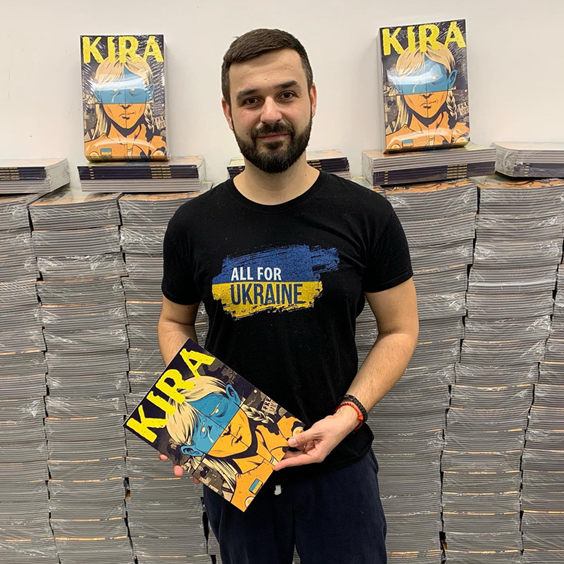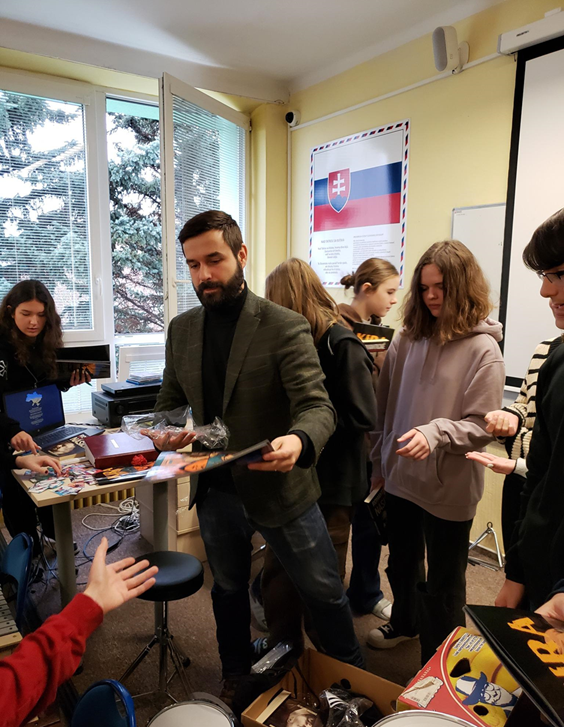The Making of Kira: Conceptualization and Production
The plot of Kira begins by highlighting one of the most tragic moments of the war—the downing of Malaysia Airlines Flight MH17 by a Buk missile system controlled by Russian forces. Kira, a young Ukrainian girl, is profoundly affected by this event, losing her mother in the disaster. This tragedy sets the tone for her journey, as Kira and her father seek refuge in Kyiv where she came to study medicine to help those in need.
On her 18th birthday, Kira awakens to the full-scale Russian invasion, realizing that nowhere is truly safe. She finds temporary safety in one of the deep metro stations where thousands of others hide from Russian bombs. There she finds family in need and helps them to give birth to a baby girl. The young family must run to safety as it is impossible to remain there for long with an infant. Therefore, they take on a dangerous journey to leave their war-torn home and seek help in one of the neighboring countries. They reach the Slovak border, but the tragedy does not end there. The family has to separate, and it is at this moment the readers realize what sacrifice is made by every single Ukrainian, refugees included.
The comic book also has an emotional epilogue that was written in the very last stage of its preparation and spoke about a further destiny of Kira. In the epilogue we see Kira being a bit older, more experienced, yet still helping those in need. She is part of a unit that is on a mission to help liberate occupied Cherson, there she gives vital first aid to one of the Ukrainian soldiers who thanks her for her help. The very next image is a picture of the soldier being hugged by an old woman from Ukraine who was shot only days before the epilogue was finished.
 Tomáš Kriššák with his "Kira" comic books.
Tomáš Kriššák with his "Kira" comic books.
The idea for Kira emerged from a need to address the long-term effects of Russian disinformation on Slovak youth, which has resulted in a significant portion of young people showing indifference to the conflict. Tomáš Kriššák, the project's lead, recognized the importance of reaching students through a medium that resonates with them—hence, the comic format. The choice of this target medium was chosen because of the previous success with educational materials made in the form of a comic book. You will not find many comic books used in Slovak schools but the perception of young people on how they enjoy the format was clear from the very beginning. Comic books remain not only great vessels for complex storytelling which is essential in the process of education, but they also proved to grasp the attention of young and old who learned the complex reality of this war through a personalized story.
The production of the paper version of Kira was a considerable undertaking. It involved a collaboration between educators, illustrators, and disinformation experts. The process was supported by a successful crowdfunding campaign, which not only provided the necessary financial resources but also demonstrated public support for the project. Organizing this effort required careful planning, with timelines for writing, illustrating, printing, and distribution all carefully coordinated. The team's dedication ensured that thousands of copies were printed and distributed to schools across Slovakia, providing educators with a valuable tool for discussing the conflict.
The comic book was almost always accepted in schools with positive feedback.
Many teachers were thankful for the material as they lacked any printed form of textbook that would touch the subject of the contemporary conflict in Ukraine that is so relevant for Slovakia as its neighboring country.
One school that did not receive a package of comic books, but instead there was only one comic book brought by one of the teachers reported a strange phenomenon. The students were so excited about the comic book that they came to borrow it from the teacher and later it was circulating continuously between them. In the end, the comic book got worn out, so the teacher asked whether they could receive new printed versions. Once the teacher shared this story, Tomas sent them a box of another 30 issues so the “reading crisis” would be averted.
Many students also admitted that even though they were in their early twenties, they never heard about the tragic downing of MH17 that happened in 2014. Even though they were already teenagers this was never introduced to them and even after 10 years of the conflict and the fact they are living next to Ukraine, they never received any kind of information that would help them know and understand the context and dynamics of the conflict.
Through its storytelling, the comic not only recounts the events of the war but also invites students to connect emotionally with the ongoing conflict, fostering a deeper understanding of Ukraine’s struggle. The ability of the comic to engage young minds demonstrates its value not just as a resource, but as an essential educational tool in a time when relevant historical and geopolitical awareness is crucial for future generations and their ability to not fall for manipulative narratives produced by many actors, especially the ones reproducing foreign propaganda.
The interesting experience was also connected to the ability of the publication to be praised by all student groups.
 The comic book was distributed in person by its author.
The comic book was distributed in person by its author.
What made the comic book even more useful was the textbook part that discussed many topics related to the history of Ukraine and its long-lasting efforts to gain and maintain its independence.
The comic book also contained all of the factual stories that were part of the plot of the comic book Kira providing even more substance and credibility to this educational tool.
The central part between the textbook and the comic book is divided by a practical test that is also helping as a way to give students space to test their newly gained knowledge and ensure that the most important information about the conflict won’t be forgotten. This way even greater level of mental immunity against propaganda is achieved.
Impact, Future Plans, and Potential Expansion
The impact of the Kira comic has been significant, not only in raising awareness among students but also in equipping teachers with a resource to tackle difficult topics in the classroom. The project has sparked discussions in schools about the conflict and the broader implications of disinformation. Looking ahead, the team behind Kira translated the comic into English to reach a broader audience. Additionally, there are plans to develop more educational materials that could form part of a series, each focusing on different aspects of the Ukrainian conflict or other pressing social issues.
 Tomáš Kriššák gives a printed copy to Czech President, Petr Pavel.
Tomáš Kriššák gives a printed copy to Czech President, Petr Pavel.
Read "Kira" online!
🔗 The online version of the comic book can be downloaded for free in both Slovak and English here!
Photos by: Tomáš Kriššák